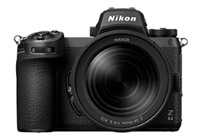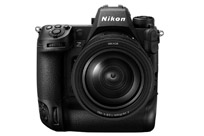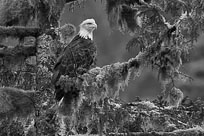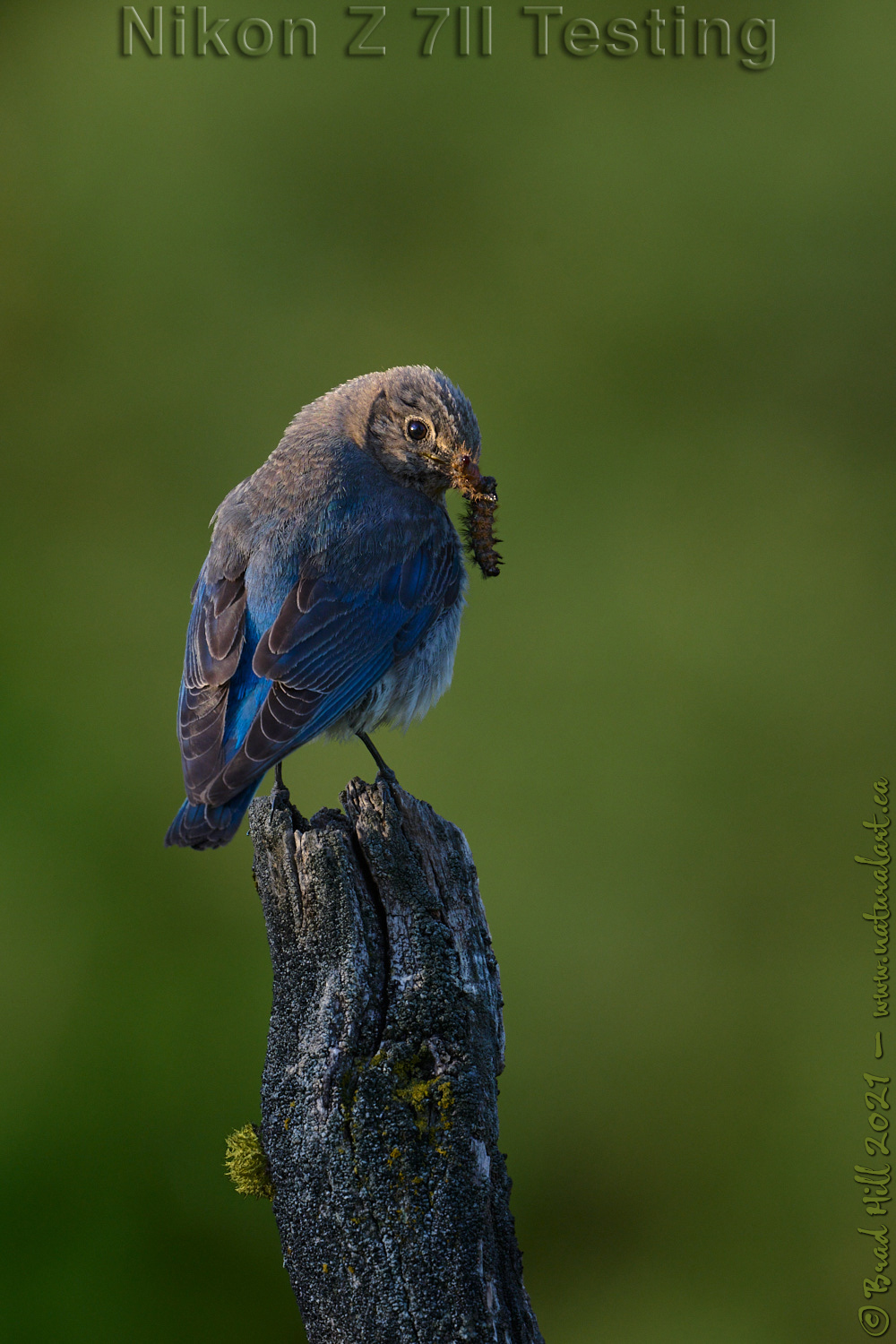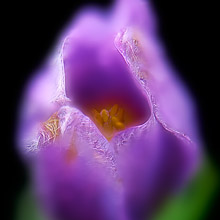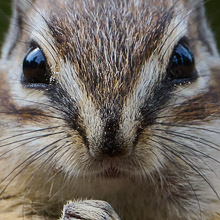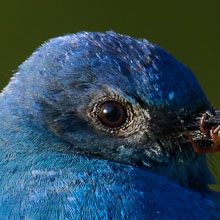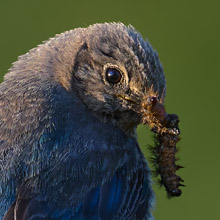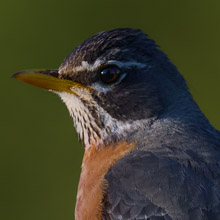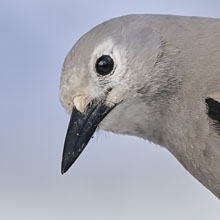Availability: Undetermined - Enquiries?
In the Field
Z 7II Testing - Break of Fast @ Break of Dawn. Findlay Creek Region (East Kootenays), British Columbia, Canada. June 4, 2021.
This is another gallery post relating my experiences with shooting wildlife using the Nikon Z 7II. This particular shot was captured JUST as the very first rays of light of the morning started to gently illuminate this female Mountain Bluebird as it was delivering a fuzzy caterpillar to its hungry nestlings. In many respects it was a lucky shot in that the total time window I had with this soft, warm light was about 6 minutes. So the chance of catching the female (and to have her give me this great pose) during this short window of time was pretty darned low. It's real gratifying when all those pre-dawn hikes carrying a packful of gear uphill (both ways!) to get to a shooting location eventually pay off!
As I've mentioned in some previous image posts, I've spent a lot of the spring shooting wildlife with Nikon's newest tandem of full-frame mirrorless cameras - the Z 7II and the Z 6II. Recently I've received a few emails from folks asking me under what conditions or situations I turn to each of the two cameras. So here's a few comments on that (following a super-brief listing of the differences between the two cameras).
Most readers will already know the Z 7II is a considerably higher resolution camera than the Z 6II. We're talking about a 46 MP camera (the Z 7II) vs. a 24 MP camera (the Z 6II). The performance correlates associated with this resolution difference include that the Z 6II is a faster camera (in frame rate) and it offers about one-stop better ISO performance. BUT...the higher resolution of the Z 7II means that you are able to crop your image more liberally and still have sufficient pixels left that you can still do a lot with the resulting image (e.g., still produce a large print). Another difference that impacts on how I use the two cameras (and that isn't fully correlated with their resolution difference) is that the Z 6II has superior low-light autofocus capabilities (even better than the D6!). A noteworthy positive of the Z 7II is that it has a minimum ISO of 64...and at that ISO (largely because of the amount of light a ISO 64 setting can "absorb") it has a crazy high dynamic range and tonal range...which translates into amazing image quality at those low ISO's. This great image quality is why dpreview.com recently bestowed the honour of best camera for landscape photography in 2021 (see the article here).
How do these performance differences translate into real-world usage differences? Well...when it comes to shooting animalscapes (think "landscape shot with an animal anchoring the image") it's a no-brainer - the resolution and dynamic range make the Z 7II the obvious choice. And, at the other end of the spectrum - in very low light conditions the better low-light focusing and ISO performance of the Z 6II make it the obvious camera of choice.
What about in the region between these two extremes (and where most of most people's shooting happens)? Well...I have found if you're shooting at ISO's up to about 2500 it's a toss-up...especially given how good noise reduction software has become in the last year or so. In the ISO 3200 to ISO 4500 or so...well...if everything else is equal I gravitate to using the Z 6II. And certainly at ISO 5000 and above I will definitely opt for my Z 6II. But...there ARE times in the mid-ISO's (let's call that ISO 1600 to about ISO 4000) when I want the extra resolution of the Z 7II (if, for no other reason, to allow me to do a little more cropping and still be left with sufficient resolution to have an image that I can still do a lot of different things with, including printing it large).
What about camera selection for this shot? Well...a number of factors collectively prompted me to go for my Z 7II. And it's important to know here that this type of shot requires quite a long focal length lens, primarily because you definitely want to keep your distance when working near a bird's nest (so as not to cause the adults to abandon the nest). In this particular case I needed to be in the 700mm-1000mm focal range to be on the safe and ethical side. My current best "solution" (in terms of image quality) for getting to the 700-1000mm focal length range is my 500mm PF with either a 1.4x TC (700mm) or 2x (1000mm) teleconverter. The 700mm lens/TC combo offers very slightly better image quality...so that was my preferred combination. And...if I chose the Z 7II I'd end up with more pixels dedicated to the subject (and hence can crop more) than if I shot with the Z 6II. So...assuming I had sufficient light to work with (i.e., I could stop down to the point I need to for DoF reasons and still shoot at an ISO below about ISO 4000) then I'd definitely opt for my Z 7II. And...even before sunrise, it was obvious it was clear out and I was sure I'd be at a fairly low ISO as soon as the sun came up. So it was a no-brainer to select my Z 7II for this shot...which I ended up shooting at ISO 800 (at 1/200s and f10). Best of all, after cropping this shot as seen above the image was down to 6400 pixels on the long axis...and with the Z 6II the same crop would have left me with only 4688 pixels on the long axis. And, any time I can end up with an extra 1700 pixels on an image by choosing a different camera (without losing any image quality), I'll do it! ;-)
At this point I am really enjoying shooting wildlife with the Z 6II/Z 7II "dynamic duo". Yes, I AM looking forward to working the coming Z 9 into my wildlife kit, but right now I'm not feeling very hard done by (at all!) when I'm out in the field with my two current Zed's.
Here's a considerably larger version (4800 pixel) of this almost coy-looking female Mountain Bluebird:
• Break of Fast @ Break of Dawn: Download 4800 pixel image (JPEG: 4.5 MB)
ADDITIONAL NOTES:
1. This image - in all resolutions - is protected by copyright. I'm fine with personal uses of them (including use as desktop backgrounds or screensavers on your own computer), but unauthorized commercial use of the image is prohibited by law. Thanks in advance for respecting my copyright!
2. Like all photographs on this website, this image was captured following the strict ethical guidelines described in The Wildlife FIRST! Principles of Photographer Conduct. I encourage all wildlife photographers to always put the welfare of their subjects above the value of their photographs.
Behind the Camera
Z 7II Testing - Break of Fast @ Break of Dawn. Findlay Creek Region (East Kootenays), British Columbia, Canada. June 4, 2021.
Compressed RAW (NEF) 14-bit format; ISO 800.
Nikon Z 7II paired with Nikkor 500mm f5.6E PF plus TC-14EIII (1.4x) teleconverter (total focal length of 700mm). Supported on Jobu Algonquin tripod with Jobu HD Mk IV gimbal head. VR on and in Sport mode. Single Area AF area mode.
1/200s @ f10; +0.33 stop compensation from matrix-metered exposure setting.
At the Computer
Z 7II Testing - Break of Fast @ Break of Dawn. Findlay Creek Region (East Kootenays), British Columbia, Canada. June 4, 2021.
RAW Conversion to 16-bit PSD file (and JPEG files for web use), including all global and selective adjustments, using Phase One's Capture One Pro 21. Global adjustments on this image were limited to a single tweak to brightness. Selective local adjustments performed using Capture One Pro's layers and masking tools. In this case selective adjustments were made on 8 separate layers and included one or more tweaks to exposure, brightness, saturation, colour (using both the Color Editor and Color Balance tools), clarity, and shadows.
Photoshop modifications were limited to the insertion of the watermark and/or text.
Conservation
Z 7II Testing - Break of Fast @ Break of Dawn. Findlay Creek Region (East Kootenays), British Columbia, Canada. June 4, 2021.
Species Status in Canada*: This species is not designated as at risk.
The Mountain Bluebird (Sialia currucoides) is a brilliantly coloured thrush found over much of western North America. Despite its name, it is NOT limited in distribution to mountain regions. In the early 1900's Mountain Bluebird populations plummeted due to loss of nesting habitat (natural cavities) due to the introduction of alien species, including House Sparrows and Starlings. An aggressive conservation effort in the form of the introduction of species-specific nest boxes worked and today bluebirds are common again.
This adult male Mountain Bluebird was photographed in the East Kootenays of BC, Canada. The area supports a strong population of Mountain Bluebirds and smaller population of Western Bluebirds.
One of the most fascinating things about the Mountain Bluebird is that the striking ultraviolet-blue coloration of feathers does not come from any type of pigment that has been incorporated into feathers. Instead, the source of the coloration is completely "structural" in that the microanatomy of the feather barbs in a way that primarily reflects ultraviolet and blue light while largely absorbing wavelengths of light that are perceived by humans as other colors (green, yellow, red, etc.). So what you are seeing is differentially reflected ultraviolet-blue light...NOT pigmentation!
*as determined by COSEWIC: The Committee on the Status of Endangered Wildlife in Canada







